Updated: 03/28/2024 – Thinking about adding a Mini Bernedoodle into your life? You are not alone.
The Mini Bernadoodle, a delightful blend of the loyal and sturdy Bernese Mountain Dog and the playful and intelligent miniature Poodle, has fast become a top contender among people looking for a dog.
Yet, what truly sets the Miniature Bernedoodle apart is its compact size. While they inherit the charm and characteristics of the standard Bernedoodle, they present it in a form that’s easier for many households to accommodate. In addition, their adaptable and affectionate nature allows them to seamlessly fit into various lifestyles.
As a doodle dog parent myself, I know that no dog breed is perfect, and the mini Bernese Mountain Dog Poodle Mix has some traits that might make you think twice before getting one.
Keep reading to discover the Miniature Bernedoodle, both the good and bad about them as told by Bernedoodle owners.
In this guide we go over what you need to know about the breed and hear what life is like with these pups from real Bernedoodle owners.

What is a Mini Bernedoodle?
A Mini Bernedoodle is a hybrid dog breed commonly resulting from the crossbreeding of a Bernese Mountain Dog and a Miniature Poodle. Known for its friendly disposition, intelligence, and low-shedding coat, it’s believed that the mini Bernedoodle combines the best traits of both the poodle parent and the Bernese Mountain Dog parent in a compact size.
But there is a downside to this crossbreed. One of them is the difference in size between the two purebred dogs. Breeding a large dog with a small dog may cause a couple of issues with the offspring including a disproportionate body.
To deal with this issue, some breeders are choosing to use a mini doodle in place of the miniature poodle parent.
Mini Australian Bernedoodle
One such variation is the mini Australian Bernedoodle. In this case a mini Australian labradoodle is used in place of the miniature poodle. Unlike the American Labradoodle, the Australian Labradoodle is a mix of a Labrador Retriever, Poodle, Irish Water Spaniel, American Cocker Spaniel, and English Cocker Spaniel.
Origins and History
Sherry Rupke of SwissRidge Kennels in Ontario, Canada, is credited with breeding the first standard Bernedoodle. Her aim was to create a doodle more fitting for family life. Unlike the high-energy Labrador or Golden Retriever, the Bernese is more relaxed and requires less exercise, making it a better choice for families.
To understand the Bernese Mountain Dog Poodle mix better let’s take a quick look at the parent breeds.
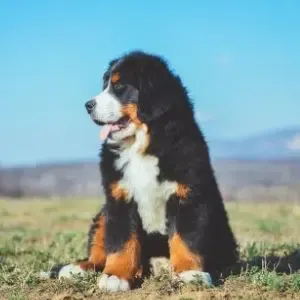
The Bernese Mountain Dog
The Bernese Mountain Dog, originating from the Swiss Alps, is a large and sturdy breed known for its striking tri-colored coat and gentle disposition. Historically used as a farm dog, they were not only valued for their strength and agility, often employed in pulling carts, but also for their protective instincts, serving as dependable guard dogs for properties and livestock.
Their temperament is affectionate and loyal, making them excellent family members. However they can be a bit reserved with new people. While they relish their outdoor activities, they equally cherish indoor family time.

The Poodle
The Miniature Poodle, originally from Germany and utilized primarily as a duck retriever, is a smaller version of the Standard Poodle. Known for its curly, hypoallergenic coat and high intelligence, the Mini Poodle ranks among the most trainable and obedient of dog breeds.
Their playful and lively nature, combined with their affectionate demeanor, makes them popular companions. Despite their smaller size, they are energetic and thrive on activity, but they also have a loving side, making them great for families and individuals alike.

Temperament
The Mini Bernedoodle’s temperament is a blend of its parent breeds. Affectionate by nature, they form strong bonds with their families, making them wonderful companions. Their high intelligence, inherited from the Poodle side, ensures they are quick learners and keen observers. However, this intelligence can sometimes translate to stubbornness, which may pose challenges during training.
While they are eager to please, their independent streak means consistent, positive training methods and patience are essential to harness their full potential. Early training is also needed to prevent bad habits from forming.
What do real Bernedoodle Owners have to say about the breed?
When you ask a Bernedoodle owner about their dog’s temperament, you generally get a mixed response. That’s because, much like people, Bernese Mountain Dog Poodle mixes are all different.
But there are common themes when it comes to the Bernedoodle. Here, we will go through each one, and hear from real Bernedoodle owners about their experiences.
First, the most common comment about the Miniature Bernedoodle’s temperament is that they are stubborn. This is also a common trait of the Bernese Mountain Dog. Here are a few comments about the Bernedoodle’s stubbornness from Bernedoodle owners along with a few tips on how to handle it:
- Bernedoodles can be stubborn one minute and sweet as pie the next. But training and treats will help; Sarah
- First year with a Bernedoodle is rough. They can be so stubborn, but it does get better; Grace
- Time and patience are definitely needed with a bernedoodle, but so well worth it. Our Max is the most lovable dog now – TJ
Another common comment about the Bernedoodle is that they are full of personality. It is often said that they can be clownish and also very vocal. This vocalization may come in the form of barking, whining or arguing through the various sounds they can make.
- The Bernedoodle is full of personality!!; Kisha H. Bernedoodle owner
Bernedoodles are known to be very affectionate, loyal to their families and love cuddle time as they get older. However, most owners report that as puppies, they are more interested in exploring the world and playing. Here’s what Bernedoodle parents say about children and cuddling.
- They are absolutely amazing with kids and love to play; Gini
- Took my pup 2 years to calm down. Now that he is older all he wants to do is cuddle. Unless it’s warm. Then he cuddles with the tile floor; Tyler- bernedoodle owner
The Miniature Bernadoodle tends to have higher energy levels than their full-sized counterparts. Here’s what Bernedoodle parents say about exercise.
- They do their zoomies twice a day to play and exercise; John – mini berniedoodle owner
- Bernedoodles are very active dogs that need a lot of exercise; Tim M.
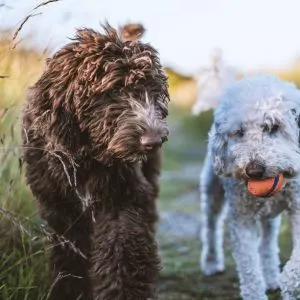
Physical Characteristics
How big is a Mini Bernedoodle?
When discussing size, the term “mini” for Bernedoodles is relative to the standard Bernedoodle size. A standard F1 Bernedoodle typically weighs between 65 and 110 pounds and stands 23 to 29 inches tall at the shoulder.
In comparison, a Miniature Bernedoodle weighs between 20-50 pounds and measures 18-22 inches at the shoulder.
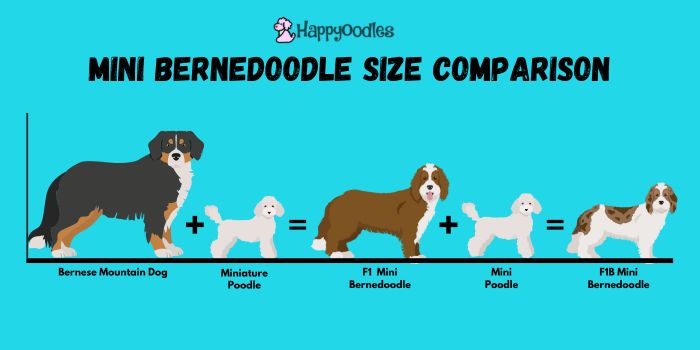
Size Variation
A 20 to 50-pound range might seem broad, and rightfully so. This variation results from the stark size differences between the Bernese Mountain Dog and the Miniature Poodle. While the Bernese Mountain Dog weighs between 75 and 110 pounds, the Mini Poodle weighs just 10 to 15 pounds. Some breeders might use a moyen poodle or mini Australian Labraoodle in the mix, further affecting size outcomes. This significant size disparity between parent breeds makes predicting the offspring’s exact size challenging, leaving some owners with a big surprise when their puppy grows larger than expected.
For more information on the mini Bernedoodle’s size, check out: Bernadoodle Full Grown: How big do they get?

Micro Mini Size
For those seeking an even smaller size, some breeders offer the Micro mini or Toy Bernedoodle. Micro mini Bernedoodles are bred using a toy poodle. This size class is the smallest among Bernedoodles, weighing between 15-45 pounds. Remember, these size classifications are all relative, especially given the naturally large size of the standard Bernedoodle.

What Colors do Mini Bernedoodles come in?
Mini Bernedoodles come in a variety of colors due to the diverse color genetics of both the Bernese Mountain Dog and the Poodle. Here are some of the most common colors and combinations:
- Tri-color: This is one of the most desired and recognized colors for Bernedoodles. It combines black, white, and rust or tan markings, mirroring the iconic Bernese Mountain Dog coloring.
- Bi-color: This can be black and white, black and rust, or even chocolate and white. Some bi-color Bernedoodles might resemble a Bernese Mountain Dog but without one of the three colors.
- Phantom: These Mini Bernedoodles showcase tan or white markings on a primarily black or chocolate coat, similar to the markings seen on Rottweilers or Dobermans.
- Merle: A merle coat has a solid base color with patches of other colors scattered throughout. This is an uncommon color in Bernedoodles and requires careful breeding practices due to associated health concerns with the merle gene.
- Solid: While less common, solid-colored Mini Bernedoodles can occur. These might be in shades of black, chocolate, or even cream.
It’s essential to understand that coat colors can sometimes be unpredictable, especially in mixed breeds. Moreover, the final adult color of a Bernedoodle might vary from its puppy color, as some colors fade or change with age.
Do Mini Bernedoodles Shed?
Many people are drawn to doodles, mistakenly believing that any breed mixed with a poodle won’t shed.
In truth, it’s not just the poodle heritage that dictates these traits, but rather the specific fur type—or more accurately, the inherited genes—that determine the degree of shedding.
First-generation (F1) Bernedoodles might inherit the straight or slightly wave coats of the Bernese or the curly, non-shedding coat of the poodle. Frequently, they possess a mix, resulting in a wavy coat. In some instances, these dogs can have an “improper” coat—a mix of various fur types.
For example, our first-generation doodle sports curly hair on her legs but long straight fur on her back and face.
An interesting indicator of a Bernese Mountain dog Poodle crossbreed’s shedding potential is its facial hair. Bernedoodles with “furnishings,” or long hair around their mouth and eyes, tend to have a low-shedding coat. Conversely, those without these furnishings, characterized by shorter, smoother facial hair, might shed more.
If you need a low-shedding dog, consider later generation Bernedoodles like the F1B or multi-gen Bernedoodle that have more poodle genetics.
F1 vs. F1 B Bernedoodle: What’s the Difference?
Throughout this post I have used terms like F1 or first generation when discussing Bernedoodles. For those new to doodles, these terms can be confusing. Breeders classified doodle generations to indicate the mix of Poodle as compared to the other breed. This classification provided insight into the dog’s likely temperament, coat type, and shedding expectations.

Is the Bernedoodle Hypoallergenic?
The hypoallergenic status of a Bernedoodle largely depends on its genetics and the type of coat it inherits. While no dog is entirely hypoallergenic, some breeds, like the Poodle, are known to produce fewer allergens than others.
A significant source of allergens in dogs is a protein found in their dander, saliva, skin cells, urine, and feces. Dander is released when a dog sheds their fur. People with dog allergies typically react to this protein when it gets into the air.
Bernedoodles can inherit the Poodle’s curly, less-shedding coat. Such a coat tends to release fewer allergens, making these Bernedoodles more suitable for people with mild allergies. Conversely, if the Bernedoodle inherits the straighter, more shedding coat of the Bernese, it might release more allergens into the air.
Regardless of the coat type, allergy sufferers should spend time with a Bernedoodle before bringing one home, to gauge their allergic response and ensure a comfortable coexistence.
Health
What is the lifespan of a Mini Bernedoodle?
The typical life expectancy is 12 to 15 years, influenced by factors like genetics, health, diet, and care. This longevity can be attributed to its Mini Poodle parent, which averages a lifespan of 13 to 15 years, and in some cases, even reaches 18 years. In contrast, the Bernese Mountain Dog tends to have a notably shorter lifespan, averaging just 6 to 10 years.
Health Concerns
While the Mini Bernedoodle, is considered to have good health thanks to hybrid vigor, they can still inherit health conditions from both parent breeds. Here are some potential health issues to be aware of:
- Hip Dysplasia: A common issue in many larger breeds, including the Bernese Mountain Dog. It’s a genetic condition where the thigh bone doesn’t fit into the hip joint properly, which can lead to arthritis or pain.
- Elbow Dysplasia: Another joint problem where abnormal development of the elbow joint can lead to pain and lameness.
- Eye Conditions: Both Bernese Mountain Dogs and Poodles can have a variety of eye conditions, including Progressive Retinal Atrophy (PRA), cataracts, and others.
- Addison’s Disease: More common in Poodles, this condition affects the dog’s adrenal glands and can lead to symptoms like lethargy, vomiting, and weight loss.
- Skin Issues: Some Mini Bernedoodles can develop skin problems, including hot spots and allergies.
- Von Willebrand’s Disease: A genetic bleeding disorder common in both Poodles and Bernese Mountain Dogs.
- Cancer: Bernese Mountain Dogs, in particular, have a higher risk of certain types of cancers.
- Degenerative Myelopathy: A progressive disease of the spinal cord that can cause lameness.
- Sebaceous Adenitis: A skin condition common in Poodles where the sebaceous glands become inflamed.
It’s important for potential owners to be aware of these health concerns and to choose breeders who prioritize health screening and responsible breeding practices. Regular veterinary check-ups, a balanced diet, and proper exercise can also play a crucial role in ensuring a Mini Bernedoodle’s overall health and well-being.
Care and Maintenance
Exercise Requirements
Adult Mini Bernedoodles generally need around 2 hours of exercise daily. This can encompass regular walks and playful time in a fenced in yard. Puppies might need additional playtime, but try not to make them overtired. An overtired puppy can start to exhibit bad behaviors like biting. If they begin biting excessively, it’s likely time for a nap.
Tip: Every Mini Bernese Mountain dog Poodle crossbreed is unique. Observe their behavior for cues on their exercise needs. Mischievous actions can often indicate a need for more engagement.
When do Bernedoodle puppies start to settle down?
A frequent question from new puppy owners is when will their puppy start to calm down. Typically, most owners find their puppies settling down around the one-year mark. This is somewhat early compared to breeds like Labradoodles or Goldendoodles, which may take 18 months to 2 years.
Coat Maintenance
Bernedoodles, like other doodle breeds, require consistent coat maintenance. Regular brushing and the occasional trim every 4 to 6 weeks are essential. The exact grooming frequency depends on their specific fur type and length. Longer, curly hair is more susceptible to tangling and thus needs more attention.
Regular trims are essential to prevent matting. Grooming can either be a DIY task or done by a professional. Costs differ based on location, your dog’s size, and their behavior during sessions. Typically, grooming charges range from $65 to $120.
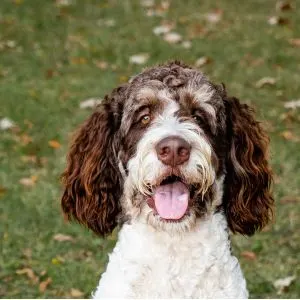
Bernedoodle Cost and Where to Find One
How much does a Mini Berniedoodle Cost?
The cost of a Mini Bernedoodle puppy varies based on factors like breeder reputation, location and coat type. Reputable breeders who prioritize health and early socialization typically charge more. Unique coat colors or patterns may also command higher prices.
On average, a cost can range from $2,500 to $5,000. It’s crucial to research breeders thoroughly, ensuring they emphasize health and ethical breeding. If you would prefer to have your puppy trained before you bring them home, so you can skip the puppy blues, the price tag goes up to 15K.
To learn more about what goes into the cost read our post Mini Bernedoodle Price: What do they cost?
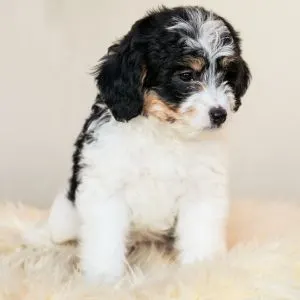
Where to find One?
- Reputable Breeder: Always research and choose a breeder who follows ethical breeding practices. They should conduct health screenings, offer a health guarantee, and be transparent about their breeding dogs’ health and living conditions.
- Rescue Organizations: Occasionally, Mini Bernedoodles end up in rescue organizations or shelters. The cost to adopt an adult mini Bernedoodle can range between $250 and $600 depending on the age of the dog and the adoption agency. The adoption fees for a young puppy may be higher.
How long does it take to get a Mini Bernedoodle from a Breeder?
It’s common to have to wait 6 to 12 months for a puppy from a quality breeder. If you want a Bernadoodle with tri-color markings the wait can be even longer.
Bringing Home a Puppy
Once you decide you want a Miniature Bernedoodle, you should start thinking about what you need for when you bring your puppy home. Puppies require many things, like a leash and collar, food bowls and toys.
One of the things you might not think about is where your puppy will go to the bathroom. Having an established place to train your puppy to go outside will make potty training easier. To learn more, check out our posts on Potty Training a Puppy: Made Easy and Outdoor Dog Potty Area Guide.
For naming ideas check out our post on 775+ Bernedoodle Dog Names: The Ultimate
Ever wonder why dogs like to sleep on their humans? Find out in our post 6 Reasons Why Your Dog Sleeps On Top of You
Thank you for stopping by
Note: We do not endorse any of the breeders linked to on this page.
Mini Berniedoodle Resources
- About Bernedoodles – Swiss Ridge Bernedoodles
- Bernese Mountain Dog -AKC
- Poodle AKC

Mary Ann Verbeke
Thursday 10th of August 2023
I found my mini Berne doodle in May. Lulabelle was 6 weeks when I brought her home. She is a true joy! Funny, playful, curious, smart, sassy, gentle, eager and I love her to pieces. She is a rescue.
Lulu is now 5 months old and losing her baby teeth. Most of the new teeth have erupted with no problems so far. She is about 12 lbs. and 12" tall. She will be spayed in the next month. Everyone who has met her loves her and many want her to become a mom so they can have one like her. NO! To me she is priceless and a loving companion for me and my 5 yr. old Yorkie.
After seeing all the rescued pups and dogs in the shelters, I see no benefit in bringing more puppies into the world. There are far too many out there without loving homes.
When will a law be passed to put puppy mills and unscrupulous breeders out of business?
Bonnie
Thursday 10th of August 2023
Hi,
Congratulations on your Bernedoodle! Sounds like you are having a wonderful time with her.
Thanks for stopping by and leaving a comment. Let us know how big she gets when she is full grown.
Bonnie